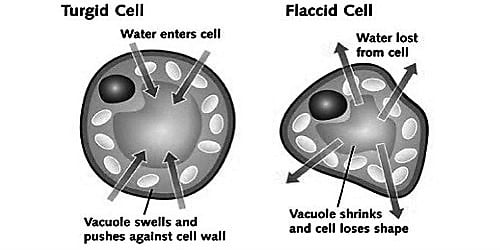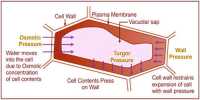A cell in it’s fully expanded condition is said to be Turgid.
Turgidity is the state of a cell in which the cell wall is fully expanded due to the absorption of water up to the last limit. Turgid is when there is a lot of water in the cell, sort of making a hydrostatic skeleton because plants don’t have bones to keep them stiff, flaccid is when the water has left the cells and the plant goes all droopy.

Turgidity is the condition of being turgid or swollen, particularly due to high fluid content. It is due to the entry, by osmosis, of a flow of water into the plant cell and its vacuole. Usually, turgor pressure is caused by the osmotic flow of water and occurs in plants, fungi, and bacteria. The pressure formed by this flow of water, or turgor pressure, rigidifies the spongy parts of the plant (stems, leaves, petals). Turgidity is necessary for plant cells to create them stay standing upright. Usually, these pressures counterbalance each other and a state of equilibrium is maintained between them.
Plant cells that lose much water have less turgor pressure and tend to become flaccid. Additional water loss ultimately results in the wilting of the plant. Three factors influence the turgidity of a living cell. These are: (a) structure of osmotically active substances surrounded by the cell, (b) a sufficient supply of water, and (c) a semi-permeable membrane.
Significance of Turgidity
- It assists in the faction of nutrient solutions from cell to cell. This is because of the dissimilarity in the absorption of the cell sap between one cell and the other
- Turgidity is necessary for plant cells to make them keep position standing. Plant cells that lose lot of water have less turgor pressure and tend to become flaccid.
- It is essential for the development of dissimilar organs.















